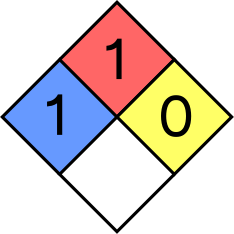SODIUM ACETATE ANHYDROUS
Basic information
- Chemical formula(s): \({\rm CH_3COONa}\), \({\rm C_2H_3NaO_2}\)
- Other names: acetic acid sodium salt
- CAS: 127-09-3
- International Chemical Safety Card (ICSC): 0565
- Flammability: yes - requires considerable preheating
- Description: anhydrous salt is a colourless crystalline solid, very soluble in water, moderately soluble in ethanol, the gas is odourless or has a faint acetous odour, It effloresces in warm, dry air
NFPA 704 (fire diamond)

- Health (blue): 1 - poses no health hazard, requires no precautions, and would offer no hazard beyond that of ordinary combustible materials.
- Flammability (red): 1 - materials that require considerable preheating, under all ambient temperature conditions, before ignition and combustion can occur. Flash point above 250 °C.
- Instability–reactivity (yellow): 0 - normally stable, even under fire exposure conditions, and is not reactive with water.
- Special notice (white): -
Hazard statements
| Code | Phrase |
|---|---|
| H303 | may be harmful if swallowed |
| H333 | may be harmful if inhaled |
| H316 | causes mild skin irritation |
| H320 | causes eye irritation |
Precautionary statements
| Code | Phrase |
|---|---|
| P302+P352 | IF ON SKIN: wash with plenty of soap and water |
| P303+P361+P353 | IF ON SKIN (or hair): remove/take off immediately all contaminated clothing, rinse skin with water/shower |
| P304+P340 | IF INHALED: remove victim to fresh air and keep at rest in a position comfortable for breathing |
| P305+P351+P338 | IF IN EYES: rinse cautiously with water for several minutes, remove contact lenses, if present and easy to do, continue rinsing |
| P337+313 | IF EYE IRRITATION PERSISTS: get medical advice/attention |
Protective measures
Gloves
Occupational Safety and Health Act of 1970 and OSHA Glove Selection Chart categorize gloves into four protection levels (very good, good, fair, poor (not recommended)) for given chemical. The levels of protection against anhydrous sodium acetate for four types of gloves are:
- Neoprene: very good.
- Natural latex or rubber: very good.
- Buthyl: very good.
- Nitrile: very good.
Safety goggles
- Always wear safety goggles when handling anhydrous sodium acetate. Corrective glasses are not considered safety googles.
- Handle anhydrous sodium acetate inside the fume hood only (with exception of moving the closed bottle to and from the storage cabinet).
Clothing
- Wear long trousers and fully covered shoes.
- Contact lenses are forbidden while working with chemical substances, even in combination with safety glasses.
- Do not wear cosmetics.
- Do not wear synthetic clothing while working with flammable liquids or gases or when a hazard is present as these materials tend to melt and stick to exposed skin.
- Do not wear headphones.
Spill management
- Use personal protective equipment.
- Avoid dust formation, avoid breathing dust.
- Avoid breathing vapors or mist.
- Ensure adequate ventilation.
- Evacuate personnel to safe areas.
- Sweep up without creating dust and arrange disposal.
- Do not let it enter drain.
- If a spill happened outside the fume hood (on the floor or desktop) contact Dr Jakub Tkaczuk (+41 44 632 31 62) and the ETH Emergency Desk (+41 44 342 11 88 from mobile or 888 from landline).